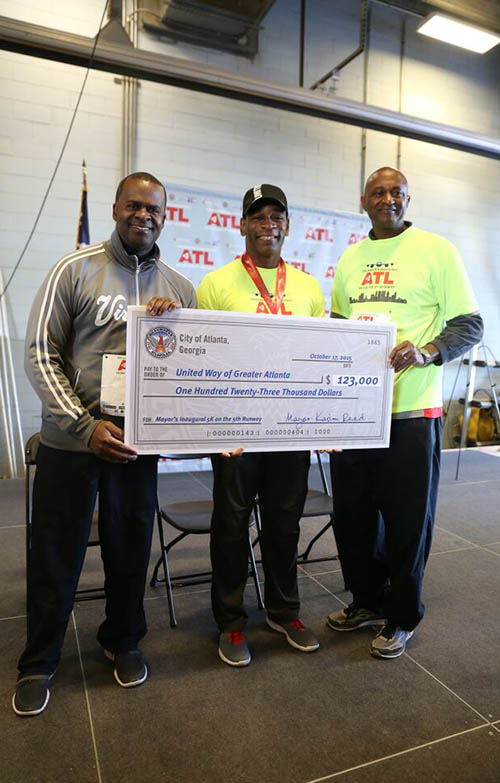
Photograph by Matt Walljasper
On nearly any weekend, somewhere in metro Atlanta, there’s a 5K race. Most of them take place on streets or trails, but this past weekend, the Mayor’s Inaugural 5K on the 5th Runway sent around 2,000 runners, including myself, down an actual runway at Hartsfield-Jackson Atlanta International Airport.
The race was a brainchild of Mayor Kasim Reed, who approached the city’s Department of Aviation about organizing the event to raise money for the United Way of Greater Atlanta. Aviation General Manager Miguel Southwell immediately latched on to the idea. Commenting in the event’s press release, he said, “Not only is this a fun and engaging way to experience a race, but it will also give visitors a different perspective of the Airport.”
Executing the event, though, proved complicated. “We started planning four months ago,” said Reese McCranie, director of communications for Hartsfield-Jackson. “We worked very closely with the FAA [and] were able to choose a day, and a time of day, where there would be minimal traffic. There were lots of moving parts: Airside operations, groundside ops, security, maintenance, TSA, Atlanta Police Department, and other agencies were involved to make sure we were able to pull this off successfully.”
Why the 5th Runway (aka Runway 10/28)? Two words: safety and security. According to McCraine, “[The 5th Runway] works from a security perspective. It’s south of the airfield complex and isolated from other parts of the airfield. It makes it a little bit easier to handle a couple thousand people.” After all, aircraft were still taking off and landing at Hartsfield-Jackson during the race.
On the day of the race, I parked (as directed) at Georgia International Convention Center, where a shuttle bus transported me to Fire Station 33, located just off of the 5th runway. (Other runners caught some of the first MARTA trains of the day down to the Airport station.) We all had arrived early for the race’s 7:00 a.m. start time.
Off the shuttle, my next stop was packet pickup, where I collected my racing bib. (Because of security, this couldn’t be done in advance, as is the case with most races.) And just like when you travel through Hartsfeld-Jackson, I had to present a government ID matching my registration information exactly. There were no body scans, though; I just had to empty my pockets.

Photograph by Matt Walljasper
Inside the crowded firehouse, spirits were high. I grabbed a banana and milled around. Speakers blared an unending loop of rowdy pop music, which drowned out the noise of the aircraft engines. (The planes actually weren’t that much louder than what you’d hear in the domestic side parking lots.) Finally, we were cleared onto the taxiway for lineup.
The tarmac was chilly, with the temperature hovering in the mid-40s. The only illumination was from a few floodlights and the unusually clear pre-dawn sky. Mayor Reed, sporting a gray tracksuit and race bib #1, spoke from atop an airport fire engine, flanked by Southwell and United Way of Greater Atlanta President Milton J. Little Jr. A few minutes later, as early morning arrivals and departures roared from the other four active runways, everyone set off.

Photograph courtesy of United Way of Greater Atlanta
The biggest concern on the taxiway was the lack of light. More than a few times I found myself only vaguely aware of my surroundings. I was glad the slab of concrete beneath my feet was large enough to accommodate wide-body aircraft—it gave us plenty of room to fan out. The course followed the taxiway to the west for nearly three-quarters of a mile before turning onto Runway 10/28 (the one that sends planes soaring over I-285). From there, we sped down nearly 7,200 of the runway’s 9,000 feet. Around this time, the early morning light began to peek out from behind the horizon, silhouetting the runners in front of me against a beautiful Georgia sunrise.
As you might imagine, 10/28 is very flat. In fact, there’s only a two-foot elevation change from end to end—and we were technically headed downhill. The pavement is also grooved to prevent water build-up, though it really doesn’t feel any different if you’re running in a decent shoe.
The only real obstacle I had to watch for was the concrete’s edges. It’s nearly a three-inch drop-off from the slab onto the surrounding grass. Hit one of those, and you could roll an ankle.
Monotony was also an issue. The horizon was fixed, the runners were fixed, and only the buildings shifted location slightly. Still, it was oddly hypnotic, like driving down a lonely stretch of road at night.
Closer to the eastern end of 10/28, we returned onto the taxiway for a sprint to the finish line back at the firehouse. After completing the course, though, I studied my Nike+ app and noticed something odd—the race wasn’t actually five kilometers. I compared my results with those of some other runners, and the GPS data consistently showed the final length at roughly 2.6 miles, or around 4.5 kilometers—a difference too large to be accounted for by accidentally cut corners. I asked McCraine about it, and he admitted, “The race actually was not a certified 5K. It was mapped out a couple of days before correctly, but it was incorrectly laid out. I think we weren’t able to see exactly where [the course was] going. The runway was closed, the runway lights were off, and it was pitch black.”

Photograph courtesy of United Way of Greater Atlanta

Photograph courtesy of United Way of Greater Atlanta
Despite the error, few runners seemed upset over the distance; many were just happy to collect the bragging rights of being on a runway. The race also raised over $123,000 for United Way. It was won by 15-year-old Andrew Murfee of College Park with an official time of 16:10.40. (I could brag and say I beat Kasim Reed’s time of 40:03:81, but then again, nobody wanted to stop and take selfies on the course with me.)
Reed said he hoped this would become an annual race—and it will. “It is definitely greenlit [for next year],” McCraine said. “We’ve got key learnings from the inaugural event, and we’ll take what’s happened and improve upon it. We’ll make sure the race is certified and hopefully move it closer to September, when it’s a little warmer and a bit lighter as well.”
Regardless of the hiccups, when you’re out there on the runway, and can look down and see the streaked rubber char from thousands of aircraft take-offs and landings—it’s pretty awe inspiring. And this isn’t just any runway. It’s the runway of the world’s busiest airport. That’s something special.










![The North Carolina Museum of Natural Sciences’ newest exhibit is a [pre]historic first](https://cdn2.atlantamagazine.com/wp-content/uploads/sites/4/2024/04/DD-3-100x70.jpg)


